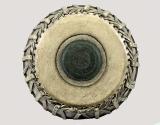Home
>
Works
>
Barrel drum
>
Advanced Search
Folk, Indigenous, and Global
Drums
Barrel drum
Vernacular name:Mridangam
Vernacular name:Mridanga
Date: 1900-1925 ca.
Place Made:India, Asia, southern region
Serial No: none
Signednone
Markingsnone
DescriptionThis double-headed drum is used in Carnatic music and to accompany dancing. According to Hindu mythology, the mridangam (literally, "body of clay") is the invention of the god Brahma ("The Creator"). Jackwood body with two drumheads usually tuned in octaves. The right head is made of three layers: the siyahi (a mixture of rice, manganese dust, iron filings and other substances) forms the "black eye" in the center; the base layer of leather is traditionally made from monkey skin; and the rim, or kinnara, of bull hide. The right side is designated the female voice, while the left is the male. Traditionally, players sit cross-legged on a mat with the drum resting on its side (the smaller head at the player's right).
DimensionsOverall length: 475 mm
Maximum diameter: 265 mm
Maximum diameter: 265 mm
ProvenancePreviously owned by Reverend Emmons E. White, Manamadurai, India. By 1947, likely sold to Arne B. Larson, Brookings, South Dakota.
Terms
Credit Line: Arne B. Larson Collection, 1979
On view
Published ReferencesCross, Thomas E. Instruments of Burma, India, Nepal, Thailand, and Tibet, SMM Catalog, Vol. II (1982), pg. 7.
Thomas E. Cross, Instruments of Burma, India, Nepal, Thailand, and Tibet in theCollections of the Shrine to Music Museum, MM Thesis, University of South Dakota, 1983, page 15, plate IV.
André P. Larson, The National Music Museum: A Pictorial Souvenir (Vermillion: National Music Museum, 1988), p. 29.
Smith, Sarah E. “Percussion Instruments in America’s Shrine to Music Museum,” Percussive Notes Vol. 37, No.1 (February 1999), p. 7.
Thomas E. Cross, Instruments of Burma, India, Nepal, Thailand, and Tibet in theCollections of the Shrine to Music Museum, MM Thesis, University of South Dakota, 1983, page 15, plate IV.
André P. Larson, The National Music Museum: A Pictorial Souvenir (Vermillion: National Music Museum, 1988), p. 29.
Smith, Sarah E. “Percussion Instruments in America’s Shrine to Music Museum,” Percussive Notes Vol. 37, No.1 (February 1999), p. 7.
Object number: 01190





